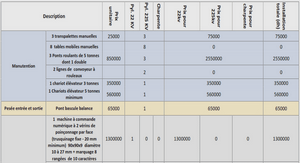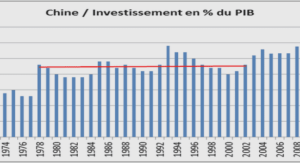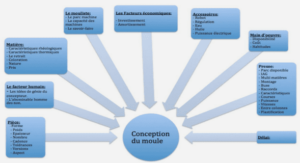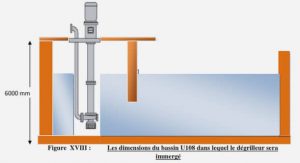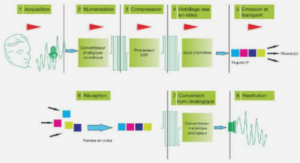Télécharger le fichier original (Mémoire de fin d’études)
FROM LOW TO HIGH-THROUGHPUT LEAF GROWTH ANALYSES: A TENDENCY TOWARDS SIMPLIFICATION OF THE DYNAMIC LEAF SYSTEM
Automated platforms have been developed in many groups allowing the culture of a high number of plants, i.e., hundreds to thousands, in greenhouses or growth-chambers.26–32 Plants grown in these platforms are either imaged or their aerial organs are attached to displacement transducers for the nondestructive measurement of shoot growth (see Figure 2, http://www.plantaccelerator. org.au/ and http://bioweb.supagro.inra.fr/phenodyn/) as examples). Because of its small size, short life cycle, and the genetic resources available in different stock centers, Arabidopsis thaliana has been selected as a model plant for the systematic characterization of growth and development.33,34 Many platforms are now devoted to shoot growth phenotyping in this species (Figure 2(a)–(e)).26,27,29,30 Image-processing techniques are used to integrate sequences of 2D plant organ images, issued from top–down imaging, over time with the aim to extract useful quantitative traits and compare genotypes on a robust dynamic basis (Figure 2(a)–(c)).29,31,35,36 The circadian timing at which growth measurements are performed is important when analyzing growth with 2D images, such as A. thaliana rosette expansion with pictures from above. The diurnal hyponastic leaf movements can introduce artifacts in such measurements if care is not taken to time them right.37–40 In addition, in certain environmental conditions such as high temperature or for certain genotypes, rosette area measured from above is biased because of leaf twisting, hyponasty, or overlap.29,41 In these systems, leaf angles can be corrected for by an extra side-view camera (Figure 2(a) and (d)).41 But, in general, it is argued that overlap between leaves is not considered as an issue because the rosette area imaged from the top is also the most active surface in photosynthesis.
Large-scale phenotyping initiatives have been launched in high-throughput platforms with different purposes including the identification of genotypes with larger rosette area in optimal or stress conditions, the identification of alleles controlling rosette area and its plasticity, and the functional analyses of targeted genes controlling rosette area.42–46 In most studies, adding manual information or destructive measurements (Figure 2(f)) to the automated recorded data have helped clarifying the circuitry that links the different levels of growth organization, from whole plant leaf area down to leaf production, individual leaf area or shape, cell division, cell expansion, physiological modules, and molecules.29,36,43,45–47 In all these examples, increasing the throughput of growth analyses to hundreds of plants has been made possible and has gained a deeper understanding of how shoots develop and what are the genes and the processes that contribute to growth control. However, phenotypic analyses in this high-throughput context were very simplified compared to the kinematic leaf growth analyses reported previously, i.e., either by recording easily accessible and automatically measurable traits or by limiting the temporal and/or spatial resolutions of the analyses. In the following sections, specific examples illustrate that recording phenotypic traits outside of temporal and spatial contexts can lead to biased conclusions on growth phenotypes. This article focus on examples issued from the comparison of leaf growth phenotypes in datasets obtained for A. thaliana. However, concepts and issues illustrated here can be easily translated to other determinate flowering plants. In addition, in all following examples, leaf growth phenotypes were compared in different genotypes grown together in a same experiment, i.e., a same environment to reveal the ‘genotype effect’. Examples are taken from our group, combining unpublished and published datasets which were re-analyzed and are systematically compared to results obtained by others.
PHENOTYPING LEAF NUMBER OR SIZE AT A GIVEN DATE: WHICH CONCLUSION CAN BE DRAWN?
In large collections of natural variants or mutants, hundreds of genotypes have been classified according to leaf size, shape, or number.43,45,46,48–50 Many mutants with small rosette areas were identified in these screens, whereas mutants that display larger rosettes than their wild-type are uncommon.45,22,51 In contrast, a large variability in rosette area is found in populations of recombinant inbred lines, with similar proportions of lines with increased or decreased rosette area compared to the parental lines.43,50,52,53 Quantitative trait loci (QTL) that control leaf production and/or expansion have been identified when recombinant inbred lines from a same population were grown together in high-throughput screens.43,44,50 Alleles or allelic combinations at one or a few QTLs that increase leaf area have been described and conclusions on the genetic controls of ‘leaf growth’ or ‘leaf production’ have been drawn.43,44
In these studies, leaf growth traits were measured at a given date after sowing or at a given stage. However, several examples illustrate that a static ‘picture’ of a growth trait at a given date or stage does not necessarily reflect what will be the final value of this trait. For example, when a set of 91 genotypes grown together was classified according to total rosette area or number of leaves 18 days after sowing (Figure 3(a) and (b)), the ranking did not reflect what was observed at flowering when rosette development had stopped (Figure 3(c) and (d)). Interestingly, in this dataset, there was a negative correlation between rosette area measured 18 days after sowing and the duration of leaf production estimated as the number of days between the sowing date and bolting (Figure 3(e)). The latter stage is defined as the emergence of the inflorescence in the center of the rosette, just after the last rosette leaf has emerged.1 This illustrates that rosettes expanding rapidly early in development have a tendency to stop producing leaves and transit to the reproductive phase earlier than those that expand more slowly in the beginning of their development (Figure 3(e)) and do not necessarily have a larger final leaf area (Figure 3(d)).22 The tradeoff between the initial rate of growth and growth duration is embedded in the evolutionary framework of life-history theory which predicts that the covarying values of individual characters are constrained by the use of a limited amount of resources (material, time, etc.).53 In annual plants such as A. thaliana, fitness increases with body size, which can be achieved by high relative growth rate or by extending the period of growth.54,55 Interestingly a similar trade-off has been observed at the individual leaf scale.15 Genotypes with high initial relative leaf expansion rate have generally a shorter duration of leaf expansion.15,22 All these examples support that conclusions drawn on traits measured at a given date cannot be generalized to the whole growing period and another analysis at another date or stage may lead to different conclusions, whatever the scale of growth analysis might be.
PHENOTYPING LEAF GROWTH OVER TIME: LATE DIFFERENCES CAN BE DUE TO EARLY PROCESSES
When individual leaf area or whole rosette area is plotted against time, it produces a sigmoid curve (Figures 1 and 2(e)). In many examples, such as in that in Figure 1, models are fitted to the experimental data set and genotypes are compared on the basis of parameters calculated from the selected model (see Figure 1 legend). An original logistic model was used as a basis for several extended more generalized mod-els (reviewed in ref 56). One limit to the comparison of leaf growth curves is due to the difficulty of measuring early stages of leaf expansion. Even though recent advances in microscopy and image analysis now allow for the assessment of early stages of leaf growth from leaf initiation on the meristem until emergence, the throughputs of these early measurements are typically low because of the technical constraints associated with destructive measurements and the necessity to grow a high number of plants together for sufficient replicates at each sampling time point.3,22,57 At the whole plant scale, these methods have shown that subtle differences in shoot apical meristem volumes contribute to subsequent differences in leaf emergence rate and rosette expansion rate.57,58 Similarly, at the individual leaf scale, early changes in leaf expansion rate or changes in the initial size of the primordium impact on growth dynamics later on and can alter final leaf size.11 This is due to the exponential behavior of early growth phase in which absolute leaf expansion rate at a given time depends on the leaf area at that time. It is then easy to misinterpret growth curves, as early developmental variation can cause misleading differences in late expansion.29,31 As an example, at the whole plant scale, differences in rosette area observed at a given date after sowing in a set of genotypes (Figure 4(a)) are no longer apparent when the x-scale is expressed in ‘days after leaf 2 emergence’ revealing here that differences in leaf area observed throughout the growing period were due to differ-ences in germination rates and/or early development (Figure 4(b)). This illustrates that very different con-clusions can be drawn if the time scale is normalized by developmental stages.29,31 It is important to keep in mind that phenotypic differences reported at a given date after sowing can be due to differences in germination rate.
PHENOTYPING LEAF GROWTH OVER TIME: EARLY DIFFERENCES CAN BE DUE TO LATE PROCESSES
As in other determinate flowering plants, A. thaliana shoot development is characterized by distinct phases—a juvenile vegetative phase, an adult vegetative phase during which the plant is reproductively competent, and a reproductive phase.59,60 In many examples, leaves produced during the same phase share common morphological characteristics such as, circularity, serration, or trichome distribution.61–63 The number of leaves produced during each phase varies among genotypes. As a consequence, a leaf at a given rank on a rosette with a given leaf number does not have the same ‘phenotypic status’ as a leaf at the same rank on a rosette with more leaves. They will not share the same morphological characteristics cited above. In addition they will also not experience the same microenvironmental conditions that could affect their growth. The sixth leaf on a rosette with a final number of 30 leaves does not experience the same leaf temperature, incident light, and air humidity as the sixth leaf on a rosette with a final number of six leaves, because an increase in leaf number is associated with an increase in leaf overlapping. Such variability in rosette leaf number has been observed in the Ler × An-1 population of recombinant inbred lines when all 120 lines were grown together in the same environmental condition.43 Given the important variability in total leaf number among these lines, comparing area and epidermal cell densities in their leaf 6 may not be so pertinent. In addition to the role of shoot architecture on the phenotypic values observed on individual leaf, the development of a leaf at a given rank may or may not have coincided with processes associated to whole plant reproduction. Evidence of tight relationships between vegetative development and floral transition has been recently highlighted in A. thaliana.64 The floral inducer FT has been shown to control—either directly or indirectly—some Squamosa Promoter Binding Protein-like (SPL) genes that promote the juvenile-to-adult transition and exert some control on phyllochron, leaf area, and trichome production on leaf abaxial surface.65–67 High-throughput phenotypic screens combined with statistical modeling tools have also highlighted these tight relationships, showing that delaying flowering impacts upon individual leaf expansion.43 In addition, when flowering is delayed by shortening day-length or cutting floral buds and leaf area duration of expansion and epidermal cell area in an individual leaf are increased.13 It was then suggested
Table des matières
Introduction générale
Chapitre 1 : Synthèse bibliographique
I. La résistance au stress hydrique, un enjeu majeur pour l’agriculture
I.1. Mécanismes mis en place par les plantes pour faire face au déficit hydrique
I.1.1. Le mécanisme d’échappement est lié à des modifications de la phénologie des plantes
I.1.2. L’évitement de la déshydratation
I.1.3. La tolérance à la déshydratation et la survie des plantes lors d’un stress hydrique sévère
II. Les Plant Growth Promoting Rhizobacteria (PGPR), une interaction mutualiste avec les plantes
II.1. Les PGPR interfèrent dans les mécanismes de réponses des plantes lors d’un stress hydrique
II.1.1. Les PGPR peuvent moduler la phénologie des plantes
II.1.2. Les PGPR confèrent de nouvelles capacités aux plantes via des ajustements plastiques
II.1.3. Les PGPR permettent d’améliorer la survie des plantes lors d’un déficit hydrique sévère
III. Le genre Phyllobacterium sp. dans les interactions plante-rhizobactéries
Chapitre 2 : Matériel et Méthodes & Développement méthodologique 31
I. Matériel biologique
II. Méthodes
II.1. Culture de la souche Phyllobacterium brassicacearum
II.2. Inoculation en terre et in vitro
II.3. Culture et caractérisation phénotypique des plantes cultivées en sol
II.3.1. Application de différents déficits hydriques
II.3.2. Caractérisation phénotypique des plantes cultivées en terre
II.4. Culture et caractérisation phénotypique des plantes cultivées in vitro
Développement méthodologique :
Lièvre M, Wuyts N, Cookson SJ, Bresson J, Dapp M, Vasseur F, Massonnet C, Tisné S,
Bettembourg M, Balsera C, et al. 2013. Phenotyping the kinematics of leaf development in
flowering plants: recommendations and pitfalls. Wiley Interdisciplinary Reviews: Developmental
Biology 2: 809-821.
Chapitre 3 : Plant-bacteria interaction under moderate water stress
Bresson J, Varoquaux F, Bontpart T, Touraine B, Vile D. 2013. The PGPR strain
Phyllobacterium brassicacearum STM196 induces a reproductive delay and physiological changes that result in improved drought tolerance in Arabidopsis. New Phytologist 200: 558-569.
Chapitre 4 : Plant-bacteria interaction under severe water stress
Interact to survive: Phyllobacterium brassicacearum improves Arabidopsis tolerance to severe water stress
I. Introduction
II. Results
II.1. Phyllobacterium brassicacearum STM196 strain increases A. thaliana survival under multiple scenarios of severe water deficit
II.2. STM196 strain delays and reduces mortality rate under severe water deficit
II.3. Delayed dehydration of tissues confers a higher tolerance to photosynthetic damages in STM196-inoculated plants
II.4. STM196 improves growth rate and leaf production recovery of surviving plants, and increases biomass production
III. Discussion
IV. Conclusion
V. Materials and methods
Chapitre 5 : Implication of trehalose metabolism in the interaction between P. brassicacearum STM196 and A. thaliana
I. Introduction
I.1. The manipulation of trehalose metabolism induces resistance to water stress in plants
I.2. The metabolism of trehalose is implicated in plant developmental processes
I.3. Trehalose metabolism affects sugar metabolism, carbohydrate utilization and plant physiology
I.4. Trehalose metabolism is implicated in the interaction between plants and microorganisms
II. Results and Discussion
II.1. Trehalase-modified mutants display strong modifications in their metabolism and growth that contrast with findings in TPP-TPS mutants
II.1.1. Transgenic lines with modified expression of TRE1 are affected in the level of trehalose, T6P and T6P/trehalose ratio
II.1.2. Transgenic plants over-expressing TRE1 display a better resistance to exogenous trehalose in vitro
II.1.3. Transgenic lines with modified expression of TRE1 are affected in carbon metabolism
II.1.4. Transgenic lines with modified expression of TRE are affected on growth and flowering time
II.2. Trehalase-modified lines exhibit opposite responses under moderate and severe water stress
II.2.1. Transgenic lines present modification in trehalose content but not in T6P content under MWD
II.2.2. Trehalose content is positively correlated to resistance to MWD via modifications in transpiration rate
II.2.3. Attre1KO lines are more sensible to severe drought stress than the other trehalasemodified lines
II.3. Unmodified TRE1 expression is required for Phyllobacterium brassicacearum STM196 strain action on plant responses excepted under severe stress
II.3.1. STM196 did not improve plant growth under WW and MWD conditions in transgenic lines.
II.3.2. STM196 improved plant survival under SWD in all transgenic trehalase lines
II.3.3. How to explain why STM196 was not able to promote growth in transgenic trehalase lines grown in WW and MWD conditions?
III. Conclusion
Conclusion générale
Annexe 1 : Impact de la diversité des microorganismes

